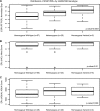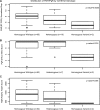ESR1 and PGR polymorphisms are associated with estrogen and progesterone receptor expression in breast tumors
- PMID: 27542969
- PMCID: PMC5111879
- DOI: 10.1152/physiolgenomics.00065.2016
ESR1 and PGR polymorphisms are associated with estrogen and progesterone receptor expression in breast tumors
Abstract
Hormone receptor-positive (HR+) breast cancers express the estrogen (ERα) and/or progesterone (PgR) receptors. Inherited single nucleotide polymorphisms (SNPs) in ESR1, the gene encoding ERα, have been reported to predict tamoxifen effectiveness. We hypothesized that these associations could be attributed to altered tumor gene/protein expression of ESR1/ERα and that SNPs in the PGR gene predict tumor PGR/PgR expression. Formalin-fixed paraffin-embedded breast cancer tumor specimens were analyzed for ESR1 and PGR gene transcript expression by the reverse transcription polymerase chain reaction based Oncotype DX assay and for ERα and PgR protein expression by immunohistochemistry (IHC) and an automated quantitative immunofluorescence assay (AQUA). Germline genotypes for SNPs in ESR1 (n = 41) and PGR (n = 8) were determined by allele-specific TaqMan assays. One SNP in ESR1 (rs9322336) was significantly associated with ESR1 gene transcript expression (P = 0.006) but not ERα protein expression (P > 0.05). A PGR SNP (rs518162) was associated with decreased PGR gene transcript expression (P = 0.003) and PgR protein expression measured by IHC (P = 0.016), but not AQUA (P = 0.054). There were modest, but statistically significant correlations between gene and protein expression for ESR1/ERα and PGR/PgR and for protein expression measured by IHC and AQUA (Pearson correlation = 0.32-0.64, all P < 0.001). Inherited ESR1 and PGR genotypes may affect tumor ESR1/ERα and PGR/PgR expression, respectively, which are moderately correlated. This work supports further research into germline predictors of tumor characteristics and treatment effectiveness, which may someday inform selection of hormonal treatments for patients with HR+ breast cancer.
Keywords: AQUA; RT-PCR; estrogen receptor; genotype; immunohistochemistry; progesterone receptor.
Copyright © 2016 the American Physiological Society.
Figures





Similar articles
-
Developmental expression patterns of gonadal hormone receptors in arcuate kisspeptin and GABA neurons of the postnatal female mouse.J Neuroendocrinol. 2025 Jan;37(1):e13477. doi: 10.1111/jne.13477. Epub 2024 Nov 28. J Neuroendocrinol. 2025. PMID: 39605295
-
Assessment of ESR1, PGR, ERBB2, and MKI67 mRNA in Hormone Receptor-Positive Early Breast Cancer: A Cross-Sectional Study.Health Sci Rep. 2025 Jul 15;8(7):e71062. doi: 10.1002/hsr2.71062. eCollection 2025 Jul. Health Sci Rep. 2025. PMID: 40666735 Free PMC article.
-
mRNA ratios of AR to ESR1 and PGR distinguish breast cancer subtypes based on public datasets and experimental models.Sci Rep. 2025 Jul 1;15(1):21793. doi: 10.1038/s41598-025-06856-3. Sci Rep. 2025. PMID: 40593140 Free PMC article.
-
Androgen receptor and estrogen receptor variants in prostate and breast cancers.J Steroid Biochem Mol Biol. 2024 Jul;241:106522. doi: 10.1016/j.jsbmb.2024.106522. Epub 2024 Apr 17. J Steroid Biochem Mol Biol. 2024. PMID: 38641298 Free PMC article. Review.
-
Pharmacological and electronic cigarette interventions for smoking cessation in adults: component network meta-analyses.Cochrane Database Syst Rev. 2023 Sep 12;9(9):CD015226. doi: 10.1002/14651858.CD015226.pub2. Cochrane Database Syst Rev. 2023. PMID: 37696529 Free PMC article.
Cited by
-
Insights into the molecular and genetic role of obesity in breast cancer pathogenesis.Cancer Biol Ther. 2025 Dec;26(1):2501345. doi: 10.1080/15384047.2025.2501345. Epub 2025 May 12. Cancer Biol Ther. 2025. PMID: 40353441 Free PMC article. Review.
-
ESR1 PvuII polymorphism: from risk factor to prognostic and predictive factor of the success of primary systemic therapy in advanced breast cancer.BMC Cancer. 2021 Dec 20;21(1):1348. doi: 10.1186/s12885-021-09083-x. BMC Cancer. 2021. PMID: 34930150 Free PMC article.
-
An Integrative Genomics Approach for Associating Genetic Susceptibility with the Tumor Immune Microenvironment in Triple Negative Breast Cancer.Biomed J Sci Tech Res. 2019;15(1):11074-11085. doi: 10.26717/bjstr.2019.15.002642. Epub 2019 Feb 25. Biomed J Sci Tech Res. 2019. PMID: 38618278 Free PMC article.
-
A Closer Look at Estrogen Receptor Mutations in Breast Cancer and Their Implications for Estrogen and Antiestrogen Responses.Int J Mol Sci. 2021 Jan 13;22(2):756. doi: 10.3390/ijms22020756. Int J Mol Sci. 2021. PMID: 33451133 Free PMC article. Review.
-
The prognostic significance of estrogen and progesterone receptors in grade I and II endometrioid endometrial adenocarcinoma: hormone receptors in risk stratification.J Gynecol Oncol. 2019 Jan;30(1):e13. doi: 10.3802/jgo.2019.30.e13. Epub 2018 Oct 29. J Gynecol Oncol. 2019. PMID: 30479097 Free PMC article.
References
-
- Anghel A, Raica M, Narita D, Seclaman E, Nicola T, Ursoniu S, Anghel M, Popovici E. Estrogen receptor alpha polymorphisms: correlation with clinicopathological parameters in breast cancer. Neoplasma 57: 306–315, 2010. - PubMed
-
- Antoniou AC, Kartsonaki C, Sinilnikova OM, Soucy P, McGuffog L, Healey S, Lee A, Peterlongo P, Manoukian S, Peissel B, Zaffaroni D, Cattaneo E, Barile M, Pensotti V, Pasini B, Dolcetti R, Giannini G, Putignano AL, Varesco L, Radice P, Mai PL, Greene MH, Andrulis IL, Glendon G, Ozcelik H, Thomassen M, Gerdes AM, Kruse TA, Birk Jensen U, Cruger DG, Caligo MA, Laitman Y, Milgrom R, Kaufman B, Paluch-Shimon S, Friedman E, Loman N, Harbst K, Lindblom A, Arver B, Ehrencrona H, Melin B, SWE-BRCA, Nathanson KL, Domchek SM, Rebbeck T, Jakubowska A, Lubinski J, Gronwald J, Huzarski T, Byrski T, Cybulski C, Gorski B, Osorio A, Ramon y Cajal T, Fostira F, Andres R, Benitez J, Hamann U, Hogervorst FB, Rookus MA, Hooning MJ, Nelen MR, van der Luijt RB, van Os TA, van Asperen CJ, Devilee P, Meijers-Heijboer HE, Gomez Garcia EB, HEBON, Peock S, Cook M, Frost D, Platte R, Leyland J, Evans DG, Lalloo F, Eeles R, Izatt L, Adlard J, Davidson R, Eccles D, Ong KR, Cook J, Douglas F, Paterson J, Kennedy MJ, Miedzybrodzka Z, EMBRACE, Godwin A, Stoppa-Lyonnet D, Buecher B, Belotti M, Tirapo C, Mazoyer S, Barjhoux L, Lasset C, Leroux D, Faivre L, Bronner M, Prieur F, Nogues C, Rouleau E, Pujol P, Coupier I, Frenay M, CEMO Study Collaborators, Hopper JL, Daly MB, Terry MB, John EM, Buys SS, Yassin Y, Miron A, Goldgar D, Breast Cancer Family Registry, Singer CF, Tea MK, Pfeiler G, Dressler AC, Hansen T, Jonson L, Ejlertsen B, Barkardottir RB, Kirchhoff T, Offit K, Piedmonte M, Rodriguez G, Small L, Boggess J, Blank S, Basil J, Azodi M, Toland AE, Montagna M, Tognazzo S, Agata S, Imyanitov E, Janavicius R, Lazaro C, Blanco I, Pharoah PD, Sucheston L, Karlan BY, Walsh CS, Olah E, Bozsik A, Teo SH, Seldon JL, Beattie MS, van Rensburg EJ, Sluiter MD, Diez O, Schmutzler RK, Wappenschmidt B, Engel C, Meindl A, Ruehl I, Varon-Mateeva R, Kast K, Deissler H, Niederacher D, Arnold N, Gadzicki D, Schonbuchner I, Caldes T, de la Hoya M, Nevanlinna H, Aittomaki K, Dumont M, Chiquette J, Tischkowitz M, Chen X, Beesley J, Spurdle AB, kConFab investigators, Neuhausen SL, Chun Ding Y, Fredericksen Z, Wang X, Pankratz VS, Couch F, Simard J, Easton DF, Chenevix-Trench G, CIMBA . Common alleles at 6q251 and 1p112 are associated with breast cancer risk for BRCA1 and BRCA2 mutation carriers. Hum Mol Genet 20: 3304–3321, 2011. - PMC - PubMed
-
- Bastien RR, Rodríguez-Lescure Á, Ebbert MT, Prat A, Munárriz B, Rowe L, Miller P, Ruiz-Borrego M, Anderson D, Lyons B, Álvarez I, Dowell T, Wall D, Seguí MÁ, Barley L, Boucher KM, Alba E, Pappas L, Davis CA, Aranda I, Fauron C, Stijleman IJ, Palacios J, Antón A, Carrasco E, Caballero R, Ellis MJ, Nielsen TO, Perou CM, Astill M, Bernard PS, Martin M. PAM50 breast cancer subtyping by RT-qPCR and concordance with standard clinical molecular markers. BMC Med Genomics 5: 44, 2012. - PMC - PubMed
-
- Berchuck A, Schildkraut JM, Wenham RM, Calingaert B, Ali S, Henriott A, Halabi S, Rodriguez GC, Gertig D, Purdie DM, Kelemen L, Spurdle AB, Marks J, Chenevix-Trench G. Progesterone receptor promoter +331A polymorphism is associated with a reduced risk of endometrioid and clear cell ovarian cancers. Cancer Epidemiol Biomarkers Prev 13: 2141–2147, 2004. - PubMed
Publication types
MeSH terms
Substances
Grants and funding
LinkOut - more resources
Full Text Sources
Other Literature Sources
Medical
Research Materials
Miscellaneous

